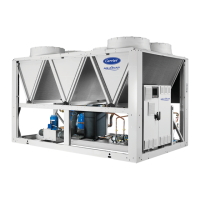
Do you have a question about the Carrier AquaSnap 30RB 672 and is the answer not in the manual?
Essential safety checks and precautions before unit installation and operation.
Safety guidelines for personnel performing maintenance on the unit.
Crucial safety protocols and precautions for unit repair operations.
Guidelines for selecting an appropriate installation location and site preparation.
Comprehensive checks required before initiating system start-up for safe operation.
Electrical data for standard units and those with option 280, including current and power.
Information on short-circuit stability current values for different unit configurations.
Electrical specifications for the hydronic module across various sizes.
Details on compressor electrical characteristics and usage parameters.
Defines the operating limits for evaporator and condenser under various conditions.
Guidelines for connecting the unit to the power supply, including voltage requirements.
Explains how to calculate and check voltage phase imbalance and its limits.
Details on the types of disconnect switches available and their installation.
Guidance on selecting appropriate wire sizes for electrical connections.
Information on connecting field control wiring for various unit features.
Further details on power supply considerations, including maintenance and disconnection.
Essential precautions and recommendations for water circuit connections and fluid compatibility.
Diagrams and details for hydronic module connections, including different options.
Methods and options for protecting the hydronic circuit from freezing.
Step-by-step guide for adjusting water flow rate using control valves for optimal operation.
Frost protection measures for the evaporator and water loop, including antifreeze concentration.
More advanced maintenance requiring specific skills, including electrical and hydronic checks.
Maintenance requiring manufacturer expertise, such as component replacement or parameter changes.
Checklist for essential pre-start-up checks of the unit's physical condition and installation.
Steps and checks required for initiating the unit's start-up sequence.
Procedure for checking and verifying voltage imbalance before chiller operation.
Checklist for verifying the evaporator water loop volume and protection measures.
Recording of key operating temperatures and pressures after unit stabilization.











